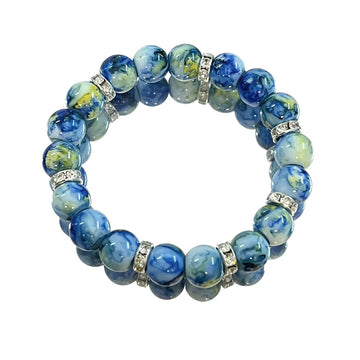The material of stone bracelets is closely related to the difficulty of their maintenance. The physical and chemical properties of different materials determine the complexity of their maintenance. Starting from the classification of common materials, the following analyzes the maintenance difficulties and targeted suggestions:
First, jade bracelets (such as jadeite and Hetian jade
Maintenance difficulties:
Fragile structure: Jade has a fibrous interwoven structure and is prone to cracking when exposed to high temperatures or sudden cooling (such as internal cracking caused by "thermal expansion and contraction").
Risk of water loss: A long-term dry environment can cause jade to lose water and its surface luster to darken (for example, Hetian jade needs to be replenished with water regularly).
Avoid chemical corrosion: Acidic and alkaline substances can corrode the surface of jade, causing color fading or structural damage.
Maintenance suggestions:
Avoid high temperatures, direct sunlight and sudden changes in temperature.
Regularly soak and replenish water with pure water (for example, once a month, for 2 hours each time).
When cleaning, use a soft cloth dipped in clean water. Do not use chemical cleaners.
Second, agate bracelets
Maintenance difficulties:
Prone to water loss and leakage: Agate requires a humid environment. A dry environment will cause a decrease in transparency (for example, Brazilian agate loses water faster than River agate).
Hardness difference: The hardness of agate is 6.5-7. but it is still necessary to avoid collision with hard objects to prevent scratches or cracks.
Maintenance suggestions:
When not worn for a long time, store it in a sealed bag with a few drops of pure water added.
Avoid contact with high-temperature and dry environments (such as direct exposure to heating or air conditioning).
When cleaning, gently brush with a soft-bristled brush and avoid scratching with hard objects.
Third, crystal bracelets (such as white crystal and amethyst)
Maintenance difficulties:
High brittleness: Crystal is fragile. Bumps and knocks may cause internal cracks or surface damage.
Avoid radiation and heat sources: Radioactive substances or high temperatures can change the color of the crystal (for example, rose quartz fades when heated).
Maintenance suggestions:
Avoid violent impacts and friction from hard objects.
Stay away from radioactive substances and high-temperature environments (such as near microwave ovens and ovens).
When cleaning, gently wipe with a soft cloth. Do not use ultrasonic cleaners.
Fourth, semi-gemstone bracelets (such as turquoise and lapis lazuli)
Maintenance difficulties:
Porosity: Materials such as turquoise are prone to absorbing water and discoloration. Long-term contact with sweat or cosmetics can cause them to lose their luster.
Low hardness: The hardness of lapis lazuli is only 5-6. It should be kept away from other hard objects to prevent scratches.
Maintenance suggestions:
Avoid contact with water, oil stains and chemicals (such as perfume, hand sanitizer).
Store separately and avoid friction with metals or other gemstones.
When cleaning, use a soft cloth dipped in a small amount of water to wipe. After it dries, apply baby oil for maintenance.
Fifth, synthetic or imitation material bracelets (such as resin, glass)
Maintenance difficulties:
Poor durability: Resin-based materials are prone to aging and discoloration, while glass-based materials are prone to cracking.
Cleaning restrictions: Chemical cleaners should be avoided to prevent surface corrosion.
Maintenance suggestions:
Avoid high temperatures and direct sunlight to prevent material deformation or fading.
When cleaning, gently wipe with a soft cloth. Do not use alcohol or acidic or alkaline solutions.







